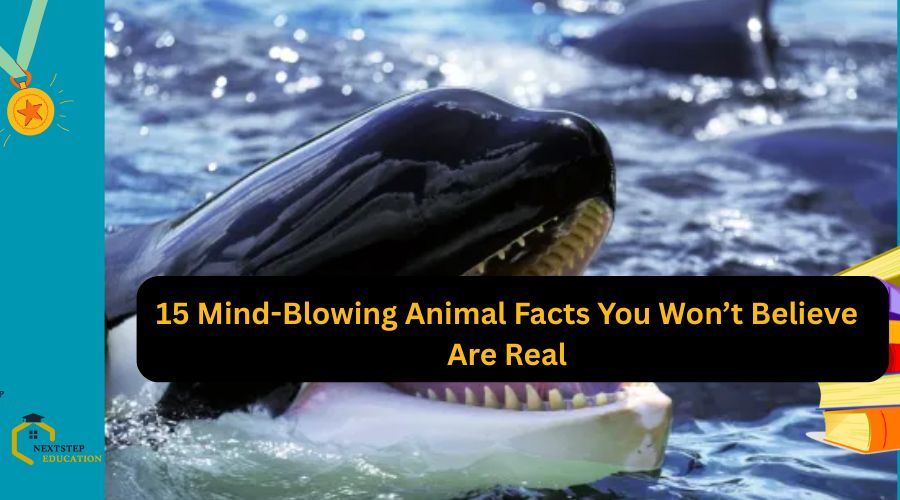Introduction: Nature Is Wilder Than You Think
Animals are full of surprises—just when you think you’ve seen it all, nature throws a curveball. From deep oceans to dense forests, the animal kingdom is packed with behaviors and traits that are hard to believe but absolutely true. Whether you’re curious, teaching your kids, or just love interesting animal facts, this list will blow your mind!
So, get ready for some fun, surprising, and strange animal facts that prove nature really is the best storyteller.15 Incredible Animal Facts That Will Blow Your Mind
🦑 1. An Octopus Has Three Hearts and Blue Blood
One of the most mind-blowing animal facts is that an octopus has three hearts! Two pump blood to its gills, while the third sends blood to the rest of its body. But here’s the twist—when it swims, the heart that serves the body actually stops beating, which is why octopuses prefer crawling over swimming.
Their blood isn’t red like ours either—it’s blue because it contains a copper-based molecule called hemocyanin, which helps them survive in cold, low-oxygen environments deep underwater. From camouflage to intelligence to this strange circulatory system, the octopus is a true alien of the ocean.
🦒 2. A Giraffe’s Tongue Is 18–20 Inches Long
Here’s a fun fact about animals you probably didn’t learn in school—giraffes have tongues up to 20 inches long, and they use them like hands to grab leaves from tall trees, especially their favorite—acacia trees, which are covered in thorns. Their tongues are not only long and flexible but also dark purple or black in color.
Why that color? It’s nature’s sunscreen! The dark pigment protects the tongue from getting sunburned while the giraffe feeds under the hot African sun for hours each day. It’s a perfect example of how evolution equips animals for survival in the most surprising ways.
🦔 3. Hedgehogs Can Hibernate for Months Without Waking
Think hibernation is just a long nap? Think again. Hedgehogs can hibernate for 4 to 6 months, during which their body temperature drops to match the surrounding environment. Their heart rate slows to just 20 beats per minute, and they breathe only a few times an hour.
They curl into a tight ball and survive entirely on stored body fat. What’s even more unbelievable is how quickly they “wake up” when spring arrives. Within hours, they’re alert and ready to forage again. This tiny mammal’s ability to slow down its metabolism is not only fascinating—it’s a survival superpower!
🐘 4. Elephants Can “Hear” With Their Feet
One of the most surprising animal facts is that elephants can actually detect sound through their feet. When other elephants make low-frequency rumbling calls—often below the range of human hearing—these sounds travel through the ground as vibrations.
Elephants pick up these seismic signals through sensitive nerve endings in their feet and trunk, helping them communicate across vast distances. They can even sense impending danger, such as thunderstorms or distant herds. This ability to feel sound is a critical survival tool in the wild, and shows just how advanced and emotionally intelligent elephants are.
🐦 5. Parrots Can Learn Hundreds of Words
Parrots aren’t just mimics—they’re among the most intelligent birds in the animal kingdom. Some species, like the African Grey Parrot, can learn and understand over 100 words, associate them with meanings, and even form basic sentences.
What makes this one of the most fun facts about animals is that parrots use their vocal learning skills to interact socially, both with other birds and with humans. Some have even shown signs of empathy, memory recall, and humor! Their advanced vocal skills make them popular pets, but they also require mental stimulation to thrive.
🦎 6. Some Lizards Can Squirt Blood From Their Eyes
Sounds like a superhero power, but it’s real! The horned lizard, native to North America, can shoot blood from its eyes to defend itself from predators. When threatened, this lizard builds up pressure behind its eyes, rupturing small blood vessels and squirting a stream of blood up to 3 feet!
The blood has a foul taste, deterring predators like foxes and coyotes. It’s one of the most unbelievable facts about animals and a perfect example of how wild and weird nature can be. The horned lizard’s other defenses include puffing up its body and camouflaging in its desert surroundings.
🐙 7. Octopuses Can Disappear Like Magic
You already know octopuses have three hearts and blue blood, but here’s another mind-blowing animal fact—they’re masters of camouflage. An octopus can instantly change its skin color and texture to blend into coral, sand, or rocks. They use specialized skin cells called chromatophores to shift shades in a flash.
But wait—it gets wilder. Some octopuses mimic other animals like lionfish or sea snakes to scare off predators. Their ability to vanish into their surroundings is one of the most unbelievable facts about animals, and a survival skill worthy of a spy movie.
🐈 8. Cats Can Make Over 100 Different Sounds
Dogs may be man’s best friend, but cats are vocal geniuses. While dogs typically make around 10 different sounds, domestic cats can produce more than 100 vocalizations—including meows, purrs, chirps, trills, growls, and even silent meows to get your attention.
This fun animal fact helps explain why cats seem so expressive. Each sound has a unique meaning depending on the pitch, volume, and context. It’s one of the most interesting animal facts that shows just how complex and mysterious our feline friends really are.
🐢 9. Some Turtles Can Breathe Through Their Butts
Yes, it sounds strange—but it’s true! Certain species of turtles, like the Australian Fitzroy River turtle, can perform a special kind of breathing called cloacal respiration, meaning they breathe through their butt.
During long dives or winter hibernation, they absorb oxygen from water through blood vessels in their rear end. It’s one of those strange animal facts that’s hilarious and educational at the same time, especially for kids. Nature always finds a weird way to keep animals alive in tough environments!
🦀 10. Crabs Can Grow Back Lost Limbs
One of the most unbelievable facts about animals is that many crabs can regenerate lost claws or legs. If a crab loses a limb during a fight or while escaping a predator, it will gradually grow it back over several molts.
This self-healing ability isn’t just about survival—it also helps crabs maintain balance, hunt effectively, and protect themselves. In fact, some crabs will intentionally shed a damaged claw (a process called autotomy) to escape danger. Talk about built-in first aid!
🐍 11. Snakes Can Sense Heat Without Touching
Snakes don’t have ears and can’t blink—but here’s a surprising animal fact: many species, like pythons and pit vipers, have heat-sensing pits on their faces that allow them to detect the body heat of their prey, even in total darkness.
This sixth sense helps them locate warm-blooded animals, making them incredible night hunters. It’s one of those interesting animal facts that reveals how different and fascinating animal senses can be compared to ours.
🐸 12. Frogs Can Freeze and Come Back to Life
This might sound like science fiction, but it’s one of the most mind-blowing animal facts: some frogs, like the wood frog in Alaska, can completely freeze during winter—heart stopped, no breathing—and then thaw out in spring alive and healthy.
These frogs produce a type of natural antifreeze in their bodies that prevents ice crystals from damaging their organs. When temperatures rise, their bodies warm, and they start functioning again as if nothing happened. A true frozen miracle in the wild!
🦑 13. Squids Have Brains Shaped Like Doughnuts
Here’s a weird but true animal fact: squids have brains shaped like doughnuts, and their esophagus (food pipe) passes right through the center of it!
This means that squids must chew their food thoroughly—otherwise, large chunks can damage their brain. Despite this odd setup, squids are incredibly intelligent, capable of problem-solving, navigation, and even communication through color changes. It’s one of the strangest animal facts in the underwater world!
🦜 14. Parrots Can Learn and Use Human Words
Some parrots can do more than mimic—they understand and use words in context. The African Grey Parrot, in particular, is known for its remarkable memory and communication skills. One famous parrot named Alex could identify shapes, colors, and even express emotions like “I’m sorry.”
These feathered geniuses are a favorite among animal lovers and researchers, making this one of the most fun and interesting animal facts for kids and adults alike.
🐘 15. Elephants Can Remember for Decades
You’ve heard “an elephant never forgets”—and it’s not just a saying. Elephants have extraordinary memory, especially for recognizing faces, remembering migration routes, or recalling water sources even after many years.
This amazing ability helps elephants survive in the wild, especially during droughts. They also grieve for lost loved ones and even hold funerals, making them some of the most emotionally intelligent animals on the planet.
Why Animal Facts Fascinate Us
Animals live in the same world we do, but their bodies, instincts, and behaviors are often wildly different from ours. From regenerating limbs to freezing solid and coming back to life, their abilities often sound like science fiction. Learning these surprising animal facts doesn’t just entertain—it also builds curiosity, awareness about biodiversity, and respect for the natural world.
These mind-blowing animal facts can also spark kids’ interest in science and make learning fun!
How We Selected These Animal Facts
To compile this list, we focused on:
-
Scientific credibility: Each fact is supported by real biology or animal behavior research.
-
Uniqueness: No common or overused facts—only unbelievable facts about animals that stand out.
-
Fun and learning value: Especially for kids, students, and animal lovers who want exciting yet factual insights.
Frequently Asked Questions (FAQs)
1. What is the most unbelievable animal fact?
One of the most unbelievable facts is that frogs can freeze completely and come back to life in spring. Their bodies use natural antifreeze to protect vital organs during hibernation.
2. Are these animal facts true or myths?
All the facts mentioned here are scientifically verified through animal studies, research journals, and wildlife documentation. No myths or fake info!
3. Can kids enjoy these strange animal facts too?
Absolutely! These facts are written to be both kid-friendly and mind-blowing. They’re perfect for learning, school projects, or just sharing cool trivia with friends.
4. Why do people love animal facts so much?
Because animals constantly surprise us! Their behaviors are often far more advanced or bizarre than we expect, and discovering those truths is both fun and educational.
5. Where can I find more fun facts about animals?
Follow our blog for more posts like this, or explore documentaries, wildlife websites, and science books made for curious minds—especially kids!




